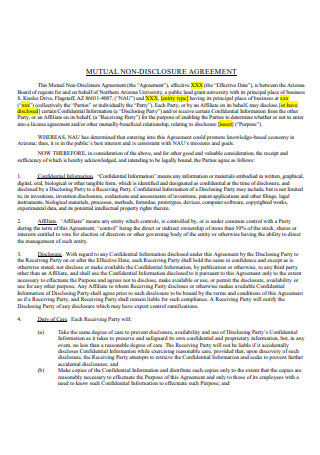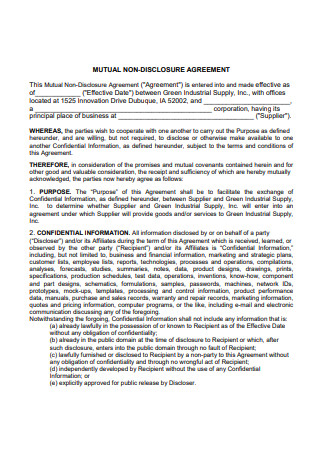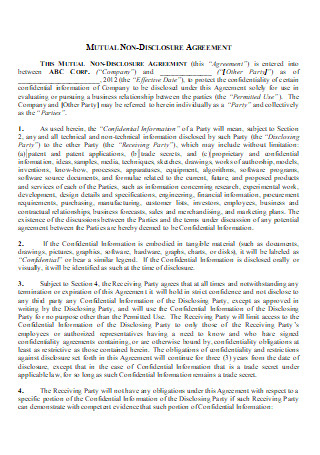16+ Sample Mutual Non-Disclosure Agreement
-

Mutual Non-Disclosure Agreement Template
download now -

Sample Mutual Non-Disclosure Agreement
download now -

Basic Mutual Non-Disclosure Agreement
download now -

Mutual Confidentially Non-Disclosure Agreement
download now -

Mutual Non-Disclosure Agreement in PDF
download now -

Corporation Mutual Non-Disclosure Agreement
download now -

Formal Mutual Non-Disclosure Agreement
download now -

Mutual Non-Disclosure Industrial Supply Agreement
download now -

Simple Mutual Non-Disclosure Agreement
download now -

Printable Mutual Non-Disclosure Agreement
download now -

Mutual Non-Disclosure Agreement Format
download now -

Company Mutual Non-Disclosure Agreement
download now -

Standard Mutual Non-Disclosure Agreement
download now -

Supplier Mutual Confidential Non-Disclosure Agreement
download now -

Mutual Non-Disclosure Agreement Example
download now -

Mutual Non-Disclosure Agreement in DOC
download now -

Confidential Mutual Non-Disclosure Agreement
download now
FREE Mutual Non-Disclosure Agreement s to Download
16+ Sample Mutual Non-Disclosure Agreement
What is a mutual non-disclosure agreement?
Types of Agreements Related to a Mutual Non-Disclosure Agreement
Other Types of Non-Disclosure Agreements
How to Make a Mutual Non-Disclosure Agreement
FAQs
Mutual vs Unilateral Non-Disclosure Agreement
Non Disclosure agreement vs Mutual Non-Disclosure Agreement
When should we sign a mutual non-disclosure agreement?
What is a mutual non-disclosure agreement?
A mutual Non-Disclosure Agreement is a legally binding document that requires both parties involved to not disclose any shared information protected by the agreement. This legal document is frequently used to keep information hidden and confidential, such as trade secrets or private information. It primarily builds a confidential relationship between the two parties and is connected to the information they exchange in the agreement. This requires the signatures of both the parties involved. The contract will also define the manner in which this information can be provided and prevent the disclosure of any information without both parties’ permission. Furthermore, such a contract will include a provision to address the consequences if either side leaks the information. It is generally used to prevent misrepresentation, theft, or abuse of specific confidential information. Example of mutual non-disclosure agreements are provided above for your reference.
This is also known as secrecy agreement, proprietary information agreement, confidentiality agreement.
Types of Agreements Related to a Mutual Non-Disclosure Agreement
Whenever there is a signing of Mutual Non- Disclosure Agreement, it usually includes other related documents, to further secure the confidential information, such as the Non-Compete Agreement and the Non-Circumvention Agreement. Let us explore these two.
Non-Compete Agreement – A non-concurrent agreement is a legal contract or a condition in a contract that requires an employee not to compete with an employer after the term has ended. These agreements also prevent the employee from providing any other party with any proprietary information or secrets during or after work. Many contracts stipulate a period when the employee is not allowed to work for a rival after he has ended his job. Employers may force staff to sign contracts not competing to maintain their market place. Employees, contractors and consultants may be asked to sign these agreements.
Non-Circumvention Agreement – The primary aim of a non-certainty agreement is to safeguard companies from being exploited. It prohibits one or more parties to a commercial transaction from being circumvented and from being robbed of full compensation for their work or participation. Furthermore, the agreement assures that the intellectual property a company reveals to another party during talks is not divulged to a third party. An uncertain party may apply a non-circumvention agreement to protect himself when he first concludes a deal with a specific party or there is insufficient confidence between the parties.
Other Types of Non-Disclosure Agreements
Aside from a Mutual Non-Disclosure Agreement, many varieties of Non-Disclosure Agreements exist and are usually categorized on the basis of the parties involved and the nature of the agreement. We will attempt to examine the other types of agreements below.
How to Make a Mutual Non-Disclosure Agreement
Provided in this article are PDFs you can download above. However if none of those satisfy your ideal Mutual Non-Disclosure Agreement, here are the steps you can follow to make one.
Step 1: Title
At the top part of the document, preferably at the center, there should be the names of the document which is the Mutual Non-Disclosure Agreement. The font must be bigger than the rest to emphasize the title.
Step 2: Introductory Paragraph
Introduce the agreement in a short paragraph to let the reader know what the next paragraphs will be all about. This may include the effective date and the entire duration of the agreement. This may also include the names of the companies involved, you just have to decide what your mutual non disclosure agreement format will be.
Step 3: Introduce the affiliates or the parties involved
Let the parties involved or the affiliates be known. “Affiliate” means any entity which controls, is controlled by, or is under common control with a Party during the term of this Agreement; “control” being the direct or indirect ownership of more than 50% of the stock, shares or interests entitled to vote for election of directors or other governing body of the entity or otherwise having the ability to direct the management of such entity.
Step 5: Inclusion of the clauses
Specific terms or clauses are included in a written contract. Clauses describe each party’s rights and duties under the Agreement. Here are the mutual non disclosure agreement example clauses:
- CONFIDENTIAL INFORMATION – This section describes what is protected from disclosure. Keep in mind that anyone who reveals secrets should confidentially identify such information. The disclosing party should communicate confidentiality if the information is communicated.
- FORM OF DISCLOSURE – Confidential information can be written, electronic, oral, visual, demonstrative, or otherwise not permanently preserved, regardless of whether such Confidential Information has specifically been identified as confidential or proprietary.
- PERIOD OF CONFIDENTIALITY AND NON-USE- This clause requires the involved parties the amount of years after the date of disclosure that they must not reveal any confidential information to any other party. That the confidential information each party has obtained from the Disclosing Party should not be revealed to the advantage of any other party, save in respect of its responsibilities to report any commercial transaction that may arise with the Disclosing Party. Nonetheless, non-disclosure requirements and use limitations on confidential data that constitutes trade secrecy of the recipient persist as long as the confidential information remains trade secret according to the agreed number of years.
- EXCLUSIONS – This clause describes all information not covered by the Agreement. The exclusion is based on judicial rulings and Indicate trade secret statutes which state that these sorts of information are not protected by commercial confidentiality.
- DISCLOSURES REQUIRED BY LAW – This clause states that If recipients be requested to disclose any confidential information to the law, regulation, government or court order, legal or similar, provided to them by Disclosing Party, the recipient shall promptly notify Distributing Party of this request to the extent that Disclosing Party may request an appropriate protection order and/or waive the execution of the provisions by the disclosing party.
- INDEMNIFICATION – This clause states that the Beneficiary party shall reimburse, indemnify and retain harmless Disclosing Party and its affiliates, owners, employees, officers, directors, agents and officials for any damages, losses, sanctions, costs, or expenses incurred by or in connection with the use or release by the Beneficiary of the Privacy Agreement and/or its associates of any such Confidential Information in breach of this Agreement.
- NOTICE OF UNAUTHORIZED USE OR DISCLOSURE – This clause states that the recipient should immediately notify disclosing party or any other third party acting on behalf of Recipient upon discovery of any unauthorized use or disclosure of confidential Information and shall cooperate with disclosing party in any and all wise manner to help disclosing party regain ownership and to prevent any further unauthorized use of confidential information.
- OWNERSHIP AND RETURN OF CONFIDENTIAL INFORMATION – The licenses, given or otherwise transferred under this Agreement shall not be granted by any patent, copyright, trademark or other property right, except as provided in this Agreement for the right to use such information. There are no internal or external warranties or guarantees of any type about information, including confidential information, which have been disclosed or made accessible under this Agreement or for any use thereof. Nonetheless, if in breach of this Agreement, the recipient provides the disclosing party a permanent, no patent file or other intellectual property rights which includes any disclosures received below.
- BINDING AGREEMENT – This clause states that the agreement shall be binding upon and inure to the benefit of the parties hereto and their respective subsidiaries, successors, assigns, legal representatives, and all corporations controlling them or controlled by them.
- INJUNCTIVE RELIEF – This clause states that the parties understand and agree that any use or dissemination of Confidential Information in violation of this Agreement will cause the other party irreparable harm, and that monetary damages may not be a sufficient remedy for unauthorized use or disclosure of Confidential Information, and that Disclosing Party may be left with no adequate remedy at law; therefore, Disclosing Party shall be entitled, without waiving any other rights or remedies, to such injunctive or equitable relief as may be deemed proper by a court of competent jurisdiction.
- ENTIRE AGREEMENT – This clause represents the entire understanding between the parties with respect to the subject matter hereof and supersedes all prior communications, agreements and understandings relating thereto. The provisions of this Agreement may not be modified, amended, or waived, except by a written instrument duly executed by both parties.
- SEVERABILITY – Should any term of this Agreement be found unconstitutional, invalid or unenforceable by the competent court, it shall continue to apply fully to the other sections. In the event that any of the duties of this Agreement is determined to be unlawful or unenforceable in respect of their length, breadth or subject matter too wide, these obligations shall be considered and interpreted by law as being limited to the maximum time, scope or matter permitted.
- COUNTERPARTS – This clause states that the agreement can be performed in two or more counterparts, including PDF copies, each with a similar effect as if the parties have signed the same document, but all combined will be the same document. The Agreement shall also be executed in the same way as a single document.
There are several other clauses you can add depending on how you want to secure you mutual non-disclosure agreement. You can check out the clauses on the mutual non-disclosure agreement templates provided above.
Step 6: Have it signed by both parties
Of course, like every other legal documents or contracts, signatures should be provided by the parties involved to ensure that they have read, understood, and agreed to everything that has been written inside the contract that they agree to the terms and to uphold your end of the bargain.
FAQs
Mutual vs Unilateral Non-Disclosure Agreement
A unilateral non-disclosure agreement is also known as a one-way non-disclosure agreement. It is the most frequent kind of non disclosure agreement used by corporations and is usually included in an employment contract. The unilateral non disclosure agreement is designed to safeguard corporate information and to avoid disclosure by the receiver of the firm’s important information. The firm makes no commitments for non-disclosure in those agreements mostly because the recipient does not have critical information. On the other hand, a mutually binding non disclosure agreement may alternatively be termed a two way non disclosure agreement or bilateral non disclosure agreement. In a bilateral non disclosure agreement, both parties agree not to divulge proprietary or private information regarding the interests of the other party. The sensitive material protected by the non disclosure agreement is also defined in the contract, just as a unilateral non disclosure agreement would.
Non Disclosure agreement vs Mutual Non-Disclosure Agreement
There are several types of non-disclosure agreements and they are categorized according to the basis of the parties involved and the nature of the agreement. One type of a non-disclosure agreement is a mutual non-disclosure agreement which refers to an agreement that is two-way or used when both the parties are required to not disclose important information to competitors. Other types of non-disclosure agreements are: Unilateral Non-disclosure Agreement, Precedent Confidentiality Agreement and Non-Disclosure Agreements for Employees.
When should we sign a mutual non-disclosure agreement?
When parties are keen to get into a commercial partnership, a non-disclosure agreement is most often signed after they identify business secrets or information that is private. Non-disclosure agreements are often designed to safeguard the secrecy of technical or business information that one or both parties deem important.
These documents are used by companies and start-ups to guarantee that their brilliant ideas are not stolen by negotiating persons. Anyone who breaks a non-disclosure agreement shall be sued and punished in terms of the value of losses of profit. There may even be criminal charges. Non-disclosure agreements can be unilateral when just the information receiver must remain silent or mutual where both parties accept not to discuss sensitive material amongst themselves. non disclosure agreements may be unilateral.
